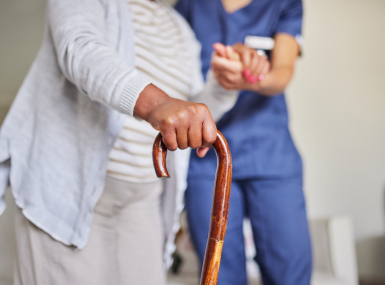Tele-behavioral health care reaches rural residents
Upcoming Events
Related News
![IMG_4484[7]_telemed.jpg Image of IMG_4484[7]_telemed.jpg](https://www.naco.org/sites/default/files/styles/807x448/public/articles/IMG_4484%5B7%5D_telemed.jpg?h=e15a1f94&itok=fIdsCCPO)
Telemedicine helps make up for lack of critical shortage of mental health providers in rural Minnesota
Mary Carpenter once had her doubts. She wasn’t “yippee-skippy” about behavioral health telemedicine, despite its promise to address mental health needs in Minnesota’s rural Arrowhead region.
“I’m a psychologist and have been working in the field for 30-plus years, and so the thought of doing it over a TV screen was like ‘yeah, right,’” said Carpenter, CEO of Range Mental Health Center in Virginia, Minn. in St. Louis County.
“But my younger therapists in the field were very excited and saying let’s try it, because there are people that don’t have transportation that we’ll never touch. So we started slow and it’s gradually taking off.”
Under a joint powers agreement, Carlton, Cook, Lake, Koochiching and St. Louis counties — collectively as the Arrowhead Health Alliance — worked with state agencies to create the Arrowhead Telepresence Coalition (ATC). County commissioners comprise the joint powers board. It provides behavioral health care through remote diagnosis and treatment of patients using internet video and audio.
The largely rural Arrowhead region makes up 23 percent of the state’s land but only 6 percent of its population. “So what we needed to do early on was to find more innovative ways to deliver services,” said Dave Lee, a psychologist and director of Carlton County Public Health and Human Services. The region takes its moniker from its pointed shape on the map, wedged between Canada and Lake Superior. Duluth is its most populous city.
Rural Minnesota faces a critical shortage of mental health providers; seven counties in the Arrowhead region have been designated as mental health professional shortage areas, according to ATC.
“In taking the lead for the region,” Lee said, “I didn’t see any other way to start to solve some of these access problems without having tele-mental health capabilities.” Carlton county did a successful “mini-pilot” before the initiative launched regionwide.
The equipment costs $1,000 to $2,000 for each telepresence unit. They were purchased with a $112,000 grant from Blue Cross/Blue Shield of Minnesota Foundation.
“Right now the coalition is providing the license and the equipment both for the school and our center, and so we don’t have a cost,” Carpenter said. “There’s no other cost than having our therapists available.”
The state’s department of human services (DHS) had been using telemedicine technology in hospitals and clinics throughout the state, but it was within state government, but not with community partners, according to Roger Root, telepresence lead for DHS. “So Arrowhead is the first pioneering community partner to be doing this with us,” he said in a video presentation about the program.
While multi-county collaboration in Minnesota is more the norm than the exception, Minnesota Association of Counties (AMC) Executive Director Julie Ring, said, “This is an exceptional example because of the number of counties, tribes and state agencies involved.”
In all, the Arrowhead Telepresence Coalition serves seven counties (including Aitkin and Itasca), three tribes, community-based mental health providers, crisis response providers, medical providers, jails and schools in collaboration with two state departments: DHS and Minnesota IT.
The coalition has received local government innovation awards from AMC and the University of Minnesota’s Humphrey School of Public Affairs.
In the Arrowhead region, it can take hours to get a child to a mental health appointment, Carpenter said. “We have one of our schools — it’s about 20 miles from the Canadian border — we have kids up in that school that usually would travel an hour south to be able to see their therapist,” she explained. “And then they see them for their clinical hour, then they would have an hour back.
“Now a child can go down a hallway, see that therapist for one hour and return to class. Parents don’t have to disrupt their day.”
Carpenter said that children, mostly middle-school-age, seem to “engage” more quickly via telepresence.
“Our outcomes are improving with teenagers, and that was surprising to me,” she said, “because I didn’t’ think this was going to work.
“But teens — their mode of communication is through electronics and doing FaceTime, and so they engage quicker, and they tend to get to the heart of their issues much faster with having the screen as the barrier and not having to go into someone’s office and have that physical presence.”
At the Carlton County Jail, inmates with behavioral health issues have also benefited from the telepresence initiative. “We have a lot of undiagnosed, untreated people in jail,” Lee said.
Jail Administrator Paul Coughlin said tele-behavioral health services are saving time and money in the roughly three years it’s been available at the jail. “Prior to that we would have an inmate that would present with a mental health need and have to go to the ER,” Coughlin said in a video. “Once they were at the ER, they would more times than not be transferred to a hospital in Duluth where the psychiatry services were.
“Since telehealth, we’re allowed to save a lot of money. We did not have to pay the psychiatrist just to travel here, paying them travel time and then their report writing time,” Coughlin added. “We are able now to hold that meeting online through the telepresence, so it’s very cost effective for us.”
Lee sees “more potential” in telehealth providing care on either side of the jailhouse door. “Both on the incarcerated side but also on the community side. So there’s less of a chance of getting lost in the shuffle once being discharged from jail.”
For the medically insured, states have played a major role in the spread of telemedicine, according to Latoya Thomas, director for the state policy resource center at the American Telemedicine Association. “One of the things they have done is to recognize that they’ve got the ability to enable state-regulated health insurers to not deny services that are already covered by that plan just because they weren’t done in person.
“And what we’ve seen over the past four years, 31 states and the District of Columbia have adopted what we call telemedicine parity laws.”
Attachments
Related News

U.S. Department of Agriculture unveils $700 million for regenerative agriculture
On December 10, U.S. Secretary of Agriculture Brooke Rollins announced the launch of a $700 million pilot program to support regenerative agriculture practices across the country.

HHS releases rule repealing federal nursing home staffing mandate, supporting county long term care facilities
On December 2, the U.S. Department of Health and Human Services (HHS) published an interim final rule that repeals the federal nursing home staffing mandate, a regulation that would have required long-term care facilities to meet strict minimum staffing levels.

Congress passes SUPPORT Act reauthorization
On September 18, the U.S. Senate passed the SUPPORT for Patients and Communities Reauthorization Act of 2025 (SUPPORT Act Reauthorization) (H.R. 2483) by voice vote, following House passage earlier this year. With strong bipartisan backing in both chambers, the legislation now heads to the President’s desk for signature.